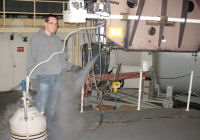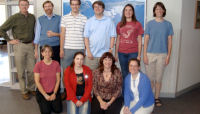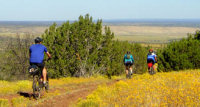Currently Available Projects
Listed below are projects that are currently available.
A full listing of Lowell faculty is
here.
Travis Barman, (928) 233-3227, barman[at]lowell[dot]edu
Modeling the Atmospheres of Exoplanets (available fall 2013) ---
The next several years will see the beginning of many surveys with new instruments tailor-made for directly imaging Jupiter-mass planets as well as directly measuring their near-IR spectra. This NSF-funded project can support one energetic student to work on atmospheric modeling with the goal of characterizing giant exoplanets. The student will learn to create, modify, and improve upon simulations of atmospheric chemistry, clouds, and radiative transfer. Some programing skills will be beneficial, especially the ability to work with (or quickly come up to speed with) FORTRAN, IDL, PERL, etc.
Kevin Covey, (298) 233-3222, kcovey[at]lowell[dot]edu
Measuring the Frequency, Duration, and Dynamics of Protostellar Accretion & Extinction Variations (available fall 2013) ---
The student will analyze photometric and spectroscopic observations of several highly variable protostars to identify the mechanism(s) responsible for source's observed variability, and their implications for the protostellar accretion and planet formation processes. Initially, the project will focus on data obtained over the past observing season; students will also have the opportunity to continue and/or expand the campaign using observing facilities at Lowell Observatory and elsewhere. Previous research experience in stellar astrophysics, and a working knowledge of IDL, IRAF/PyRAF, and/or Python will be beneficial, but not required.
Will Grundy, (928) 233-3231, W.Grundy[at]lowell[dot]edu
Spectral and thermodynamic behavior of cryogenic ices in the outer solar system (available now) ---
We are looking for a student interested in working in the laboratory with cryogenic ices and ice mixtures likely to occur on the surfaces of small icy bodies on the outermost fringes of the solar system. These ices have distinctive infrared absorption features, enabling them to be detected via telescopic observations.
Deidre Hunter (928) 233-3225, dah[at]lowell[dot]edu
Molecules, Dust, and Star Formation at Low Metallicity (available Jan 2014, pending funding) ---
The LITTLE THINGS team is exploring the effects of low metallicity on star formation through observations of the molecular structure and dust FIR-continuum emission in nearby dwarf galaxies. The pre-doc would be responsible for ALMA (CO), APEX (CO and 870 microns), JCMT SCUBA-2 (850 micron) observations, analysis, and interpretation. This will involve spending time with collaborators in Chile and UK. LITTLE THINGS is a multi-wavelength survey described here.
Lisa Prato, (928) 233-3213, lprato[at]lowell[dot]edu
Stars, Disks, and the Potential for Planet Formation in Young Binaries (available now) ---
Evgenya Shkolnik (928) 233-3220, shkolnik[at]lowell[dot]edu
The Characterization of Exoplanets and their Host Stars (available now) ---
This project will focus on the characterization of the stars and their known exoplanets, through the study of tidal and magnetic star-planet interactions. We will focus on observations of stellar activity and resulting effects on the planet using photometry and spectroscopy from both the ground- and spaced-based telescopes. In addition to access to existing data, the student will have opportunities to collect additional data at Lowell Observatory as well as at other facilities. In addition to a full salary and benefits, the student will have research funds to attend national and international conferences.
Gerard van Belle, (928) 233-3207, gerard[at]lowell[dot]edu
Sub-milliarcsecond Imaging with VISION (available March 2013) ---
The VISION (Visible Imaging System for Interferometric Observations at NPOI) instrument has recently been delivered to NPOI (the Navy Precision Optical Interferometer), has been on-sky with first light, and is undergoing commissioning. We are looking for a pre-doctoral candidate with strong instrumentation skills - both hardware and software - to contribute to the commissioning and first science with this cutting edge instrument. We anticipate that VISION will be able to image stellar surfaces of bright stars at resolutions below one milliarcsecond, offering the opportunity for unique doctoral dissertation science projects.
Links
Program Overview
Program Requirements
Application
Research Projects
About Lowell

You'll be based at Lowell's historic campus, one mile west of downtown Flagstaff at an elevation of 7,200'.

Predoctoral students have full access to the observing facilities at our dark-sky sites at Anderson Mesa and Happy Jack, southeast of Flagstaff.

Research programs at Lowell introduce students to cutting-edge collaborations with international teams.

The Flagstaff area provides a vast array of opportunities for outdoor activities, from mountain biking to skiing to horsebackriding.



